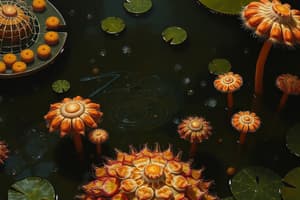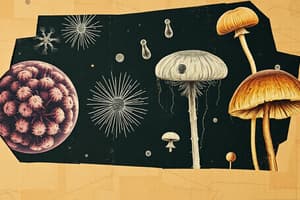Podcast
Questions and Answers
Which of the following protozoan structures is primarily responsible for regulating osmotic pressure?
Which of the following protozoan structures is primarily responsible for regulating osmotic pressure?
- Food vacuole
- Contractile vacuole (correct)
- Ribosome
- Nucleus
All protozoa are heterotrophic and obtain nutrients by consuming organic matter.
All protozoa are heterotrophic and obtain nutrients by consuming organic matter.
False (B)
The protozoan parasite Plasmodium falciparum is the causative agent of ______.
The protozoan parasite Plasmodium falciparum is the causative agent of ______.
Malaria
What is the name given to the temporary cytoplasmic extensions used by amoeboids for movement and feeding?
What is the name given to the temporary cytoplasmic extensions used by amoeboids for movement and feeding?
Match each protozoan group with its primary mode of locomotion:
Match each protozoan group with its primary mode of locomotion:
Which asexual reproduction method in protozoa involves the nucleus dividing repeatedly before the cytoplasm separates, forming multiple daughter cells?
Which asexual reproduction method in protozoa involves the nucleus dividing repeatedly before the cytoplasm separates, forming multiple daughter cells?
Conjugation in ciliates involves the fusion of two gametes to form a zygote.
Conjugation in ciliates involves the fusion of two gametes to form a zygote.
What is the term for the process by which heterotrophic protozoa engulf solid particles for nutrition?
What is the term for the process by which heterotrophic protozoa engulf solid particles for nutrition?
Which protozoan disease is transmitted by tsetse flies?
Which protozoan disease is transmitted by tsetse flies?
Euglena viridis contains ______, enabling it to perform photosynthesis.
Euglena viridis contains ______, enabling it to perform photosynthesis.
Protozoa are classified under the kingdom Animalia.
Protozoa are classified under the kingdom Animalia.
Which of the following protozoa is known to possess two nuclei, a macronucleus, and a micronucleus?
Which of the following protozoa is known to possess two nuclei, a macronucleus, and a micronucleus?
The outer, clear layer of cytoplasm in protozoa is known as the ______.
The outer, clear layer of cytoplasm in protozoa is known as the ______.
Which staining technique is used to enhance the visibility of protozoan structures under a microscope?
Which staining technique is used to enhance the visibility of protozoan structures under a microscope?
All sporozoans have specific locomotory organelles.
All sporozoans have specific locomotory organelles.
Which protozoan is responsible for causing giardiasis, a common waterborne illness?
Which protozoan is responsible for causing giardiasis, a common waterborne illness?
The sexual reproduction process in protozoa involving the fusion of two gametes to form a zygote is called ______.
The sexual reproduction process in protozoa involving the fusion of two gametes to form a zygote is called ______.
What is the role of protozoa in nutrient cycling within ecosystems?
What is the role of protozoa in nutrient cycling within ecosystems?
Which method is commonly used in research to amplify and analyze the genetic material of protozoa?
Which method is commonly used in research to amplify and analyze the genetic material of protozoa?
Protozoa have no importance in food webs.
Protozoa have no importance in food webs.
Flashcards
Protozoa
Protozoa
Single-celled eukaryotic microorganisms, classified under the kingdom Protista.
Cell Membrane (Protozoa)
Cell Membrane (Protozoa)
The outer boundary of the protozoan cell, regulating the passage of substances.
Cytoplasm (Protozoa)
Cytoplasm (Protozoa)
The internal fluid of a protozoan cell, containing organelles.
Ectoplasm
Ectoplasm
Signup and view all the flashcards
Endoplasm
Endoplasm
Signup and view all the flashcards
Nucleus (Protozoa)
Nucleus (Protozoa)
Signup and view all the flashcards
Contractile Vacuoles
Contractile Vacuoles
Signup and view all the flashcards
Food Vacuoles
Food Vacuoles
Signup and view all the flashcards
Flagellates (Mastigophora)
Flagellates (Mastigophora)
Signup and view all the flashcards
Amoeboids (Sarcodina)
Amoeboids (Sarcodina)
Signup and view all the flashcards
Ciliates (Ciliophora)
Ciliates (Ciliophora)
Signup and view all the flashcards
Sporozoans (Apicomplexa)
Sporozoans (Apicomplexa)
Signup and view all the flashcards
Autotrophic Protozoa
Autotrophic Protozoa
Signup and view all the flashcards
Heterotrophic Protozoa
Heterotrophic Protozoa
Signup and view all the flashcards
Binary Fission
Binary Fission
Signup and view all the flashcards
Multiple Fission
Multiple Fission
Signup and view all the flashcards
Syngamy
Syngamy
Signup and view all the flashcards
Conjugation (Protozoa)
Conjugation (Protozoa)
Signup and view all the flashcards
Microscopy in Protozoology
Microscopy in Protozoology
Signup and view all the flashcards
Culture Techniques (Protozoa)
Culture Techniques (Protozoa)
Signup and view all the flashcards
Study Notes
- Zoology is the scientific study of animals, encompassing their anatomy, physiology, genetics, evolution, behavior, and ecology
- It includes the classification, distribution, and conservation of animal species
- Zoology seeks to understand the diversity of animal life and the processes that govern their existence
- It incorporates various subdisciplines like entomology (insects), ornithology (birds), and mammology (mammals)
Protozoa
- Protozoa are single-celled eukaryotic microorganisms
- They are not animals, plants, or fungi, and are classified under the kingdom Protista
- Protozoa are diverse in shape, size, and mode of nutrition
- They are found in various moist habitats, including freshwater, marine, and terrestrial environments
- Some protozoa are free-living, while others are parasitic
- Protozoa play important roles in ecosystems as decomposers, predators, and components of food webs
Structure of Protozoa
- Cell Membrane: The outer boundary of the protozoan cell, regulating the passage of substances in and out
- Cytoplasm: The internal fluid containing organelles and inclusions
- Ectoplasm: The outer, clear layer of cytoplasm
- Endoplasm: The inner, granular layer of cytoplasm
- Nucleus: Contains the genetic material (DNA) and controls cell activities
- Some protozoa have one nucleus, while others have multiple
- Contractile Vacuoles: Organelles that regulate osmotic pressure by expelling excess water
- Food Vacuoles: Organelles that contain ingested food particles during digestion
- Other Organelles: Mitochondria for energy production, ribosomes for protein synthesis, Golgi apparatus for processing and packaging proteins
Classification of Protozoa
- Protozoa are traditionally classified based on their means of locomotion
- This classification is not entirely accurate due to evolutionary relationships revealed by molecular data
Major Groups of Protozoa:
- Flagellates (Mastigophora): Possess one or more flagella for movement
- Examples include Euglena, Trypanosoma, and Giardia
- Amoeboids (Sarcodina): Move and feed using pseudopodia (temporary cytoplasmic extensions)
- Examples include Amoeba and Entamoeba
- Ciliates (Ciliophora): Possess numerous cilia for movement and feeding
- Examples include Paramecium and Stentor
- Sporozoans (Apicomplexa): Typically parasitic and form spores during their life cycle; they lack specific locomotory organelles
- Examples include Plasmodium (causes malaria) and Toxoplasma
Mode of Nutrition
- Protozoa exhibit diverse modes of nutrition
Autotrophic Protozoa
- Some protozoa, like Euglena, are autotrophic and can produce their own food through photosynthesis
- They contain chloroplasts with chlorophyll for capturing light energy
Heterotrophic Protozoa
- Most protozoa are heterotrophic and obtain nutrients by consuming organic matter
- Phagocytosis: Engulfing solid particles
- Pinocytosis: Engulfing liquid droplets
- Osmotrophy: Absorbing dissolved organic molecules
Reproduction in Protozoa
- Protozoa reproduce both asexually and sexually
Asexual Reproduction
- Binary Fission: The cell divides into two identical daughter cells
- Multiple Fission: The nucleus divides repeatedly before the cytoplasm separates, forming multiple daughter cells
- Budding: A small outgrowth (bud) develops into a new individual
- Schizogony: Multiple fission that results in the production of merozoites
Sexual Reproduction
- Syngamy: Fusion of two gametes (sex cells) to form a zygote
- Conjugation: Temporary union of two cells to exchange genetic material (found in ciliates)
- Autogamy: Self-fertilization within a single cell
Ecological Importance of Protozoa
- Protozoa are essential components of aquatic and terrestrial ecosystems
Roles in Ecosystems
- Food Webs: Serve as food for larger organisms, linking microbial and macroscopic food chains
- Decomposition: Help break down organic matter, recycling nutrients
- Nutrient Cycling: Contribute to the cycling of nitrogen, phosphorus, and other essential elements
- Biological Control: Some protozoa prey on bacteria and algae, regulating their populations
- Indicators of Water Quality: Certain species are used to assess water quality and pollution levels
Protozoa and Human Health
- Some protozoa are pathogenic and can cause diseases in humans and animals
Common Protozoan Diseases
- Malaria: Caused by Plasmodium species, transmitted by mosquitoes; symptoms include fever, chills, and anemia
- Amoebic Dysentery: Caused by Entamoeba histolytica, transmitted through contaminated food and water; symptoms include diarrhea, abdominal pain, and dysentery
- Giardiasis: Caused by Giardia lamblia, transmitted through contaminated water; symptoms include diarrhea, abdominal cramps, and nausea
- Toxoplasmosis: Caused by Toxoplasma gondii, transmitted through undercooked meat or contact with cat feces; can cause congenital defects in pregnant women
- Leishmaniasis: Caused by Leishmania species, transmitted by sandflies; symptoms include skin sores, fever, and organ damage
- Sleeping Sickness (African Trypanosomiasis): Caused by Trypanosoma brucei, transmitted by tsetse flies; symptoms include fever, headache, and neurological disorders
Examples of Protozoa
Amoeba proteus
- A free-living amoeba found in freshwater habitats
- Moves and feeds using pseudopodia
- Reproduces by binary fission
- Engulfs food particles through phagocytosis
Paramecium caudatum
- A ciliated protozoan found in freshwater habitats
- Moves using cilia
- Has two nuclei: a macronucleus (controls daily functions) and a micronucleus (involved in reproduction)
- Reproduces by binary fission and conjugation
- Possesses a contractile vacuole for osmoregulation
Euglena viridis
- A flagellated protozoan found in freshwater habitats
- Has chloroplasts and can perform photosynthesis
- Moves using a flagellum
- Has an eyespot (stigma) that detects light
- Reproduces by binary fission
Plasmodium falciparum
- An apicomplexan parasite that causes malaria in humans
- Transmitted by mosquitoes
- Complex life cycle involving both mosquitoes and humans
- Infects red blood cells, leading to fever, chills, and anemia
Giardia lamblia
- A flagellated parasite that causes giardiasis in humans
- Transmitted through contaminated water
- Attaches to the lining of the small intestine
- Causes diarrhea, abdominal cramps, and nausea
Research Methods in Protozoology
- Microscopy: Used to observe the morphology and structures of protozoa, including light microscopy, electron microscopy, and fluorescence microscopy
- Culture Techniques: Used to grow and isolate protozoa in the laboratory for study
- Molecular Techniques: Used to analyze the genetic material of protozoa, including DNA sequencing, PCR, and phylogenetic analysis
- Staining Techniques: Used to enhance the visibility of protozoan structures under the microscope
- Biochemical Assays: Used to study the metabolic activities and biochemical pathways of protozoa
Studying That Suits You
Use AI to generate personalized quizzes and flashcards to suit your learning preferences.




